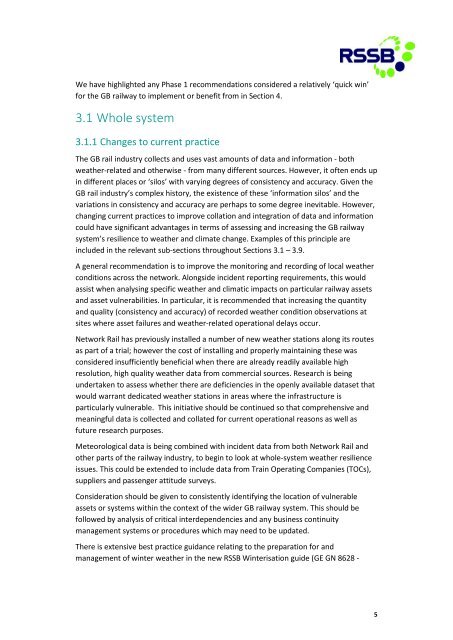Tomorrow's Railway and Climate Change Adaptation Final Report
2016-05-T1009-final-report
2016-05-T1009-final-report
Create successful ePaper yourself
Turn your PDF publications into a flip-book with our unique Google optimized e-Paper software.
We have highlighted any Phase 1 recommendations considered a relatively ‘quick win’<br />
for the GB railway to implement or benefit from in Section 4.<br />
3.1 Whole system<br />
3.1.1 <strong>Change</strong>s to current practice<br />
The GB rail industry collects <strong>and</strong> uses vast amounts of data <strong>and</strong> information - both<br />
weather-related <strong>and</strong> otherwise - from many different sources. However, it often ends up<br />
in different places or ‘silos’ with varying degrees of consistency <strong>and</strong> accuracy. Given the<br />
GB rail industry’s complex history, the existence of these ‘information silos’ <strong>and</strong> the<br />
variations in consistency <strong>and</strong> accuracy are perhaps to some degree inevitable. However,<br />
changing current practices to improve collation <strong>and</strong> integration of data <strong>and</strong> information<br />
could have significant advantages in terms of assessing <strong>and</strong> increasing the GB railway<br />
system’s resilience to weather <strong>and</strong> climate change. Examples of this principle are<br />
included in the relevant sub-sections throughout Sections 3.1 – 3.9.<br />
A general recommendation is to improve the monitoring <strong>and</strong> recording of local weather<br />
conditions across the network. Alongside incident reporting requirements, this would<br />
assist when analysing specific weather <strong>and</strong> climatic impacts on particular railway assets<br />
<strong>and</strong> asset vulnerabilities. In particular, it is recommended that increasing the quantity<br />
<strong>and</strong> quality (consistency <strong>and</strong> accuracy) of recorded weather condition observations at<br />
sites where asset failures <strong>and</strong> weather-related operational delays occur.<br />
Network Rail has previously installed a number of new weather stations along its routes<br />
as part of a trial; however the cost of installing <strong>and</strong> properly maintaining these was<br />
considered insufficiently beneficial when there are already readily available high<br />
resolution, high quality weather data from commercial sources. Research is being<br />
undertaken to assess whether there are deficiencies in the openly available dataset that<br />
would warrant dedicated weather stations in areas where the infrastructure is<br />
particularly vulnerable. This initiative should be continued so that comprehensive <strong>and</strong><br />
meaningful data is collected <strong>and</strong> collated for current operational reasons as well as<br />
future research purposes.<br />
Meteorological data is being combined with incident data from both Network Rail <strong>and</strong><br />
other parts of the railway industry, to begin to look at whole-system weather resilience<br />
issues. This could be extended to include data from Train Operating Companies (TOCs),<br />
suppliers <strong>and</strong> passenger attitude surveys.<br />
Consideration should be given to consistently identifying the location of vulnerable<br />
assets or systems within the context of the wider GB railway system. This should be<br />
followed by analysis of critical interdependencies <strong>and</strong> any business continuity<br />
management systems or procedures which may need to be updated.<br />
There is extensive best practice guidance relating to the preparation for <strong>and</strong><br />
management of winter weather in the new RSSB Winterisation guide (GE GN 8628 -<br />
5


